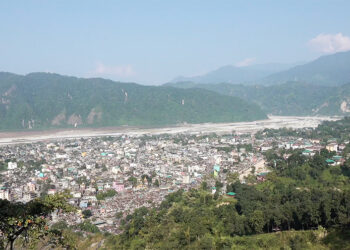 What good is a land without water? Amid the scarcity of water, farmers in Gangjab Chiwog in Nyishog Gewog in Wangdue Phodrang concluded that leaving wetland fallow made more sense than farming. More than a hundred acres of land were left fallow for years. But today, with the new irrigation channel, farmers are reviving their fallow lands.
What good is a land without water? Amid the scarcity of water, farmers in Gangjab Chiwog in Nyishog Gewog in Wangdue Phodrang concluded that leaving wetland fallow made more sense than farming. More than a hundred acres of land were left fallow for years. But today, with the new irrigation channel, farmers are reviving their fallow lands.
The last time, the farmers cultivated the paddy fields was in 2008. After that, the irrigation water source in Shar Karpai Bjeda Zachhu dried up. A vast stretch of land belonging to around 28 households was left fallow and over the years, bushes engulfed the fields.
People started depending on imported rice. Only a few continued farming with the little water channelled from nearby villages.
“Only two households near the reservoir tanks could cultivate paddy this time. They did it with limited irrigation water,” said Tashi Dendup, Gangjab Chiwog’s Tshospa.
“I tried cultivating paddy in the fallow lands about four years ago. But the yield was poor. When I heard about the irrigation water supply, I transplanted paddy. We are willing to cultivate all the fallow lands if we have water,” said Lham, a farmer from Gangjab Chiwog.
“So far, we have sustained our life by doing some vegetable works only. We even faced problems growing vegetables due to lack of water. All nine varieties of crops can grow here,” said Wangdi, another farmer in the chiwog.
However, with the newly constructed irrigation channel, the fields that were left fallow for years will be filled with green paddy saplings once again.
“I am expecting to cultivate in almost half of my fallow lands from next year. I may not be able to cultivate in all the fallow land at once. But I will try that gradually,” said Penjor, another farmer in the gewog.
The dzongkhag administration constructed the 10-kilometre irrigation channel in around one and a half years with six million ngultrum.
It was handed over to the gewog administration recently.
The irrigation water will be supplied in pipes from the source at Goga. The water will then be stored in a reservoir tank above the village and distributed to villagers.
“The gewog administration discussed with the gewog agriculture extension office to use herbicide chemicals to clean the grasses in the fallow lands. We are planning to discuss with Farm Machinery Corporation Limited in Bajo and get one power tiller on hire to encourage the people of Gangjab to do the works,” said Karma Tenzin, Nyishog Gewog’s Mangmi.
It only took the dzongkhag administration in Wangdue Phodrang to construct an irrigation channel for the farmers to revive the fallow lands in Nyisho.
Perhaps, this could be the solution for all the lands left fallow across the country.
Changa Dorji






